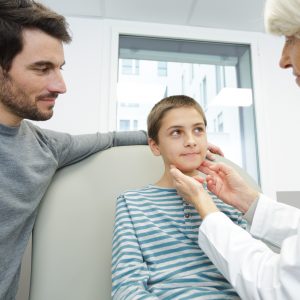Tag: Building Trust Essay Contest 2024 Winner
Breaking Silence
“For the most part, our patients are wonderful individuals but…,” our Psychiatry clerkship director paused to start passing out personal safety alarms, “you should always have your device nearby while on the unit.”
Her instructions seemed a bit dramatic for my rotation, which was set to take place on the
Child and Adolescent (CAP) unit. When we submitted our site preferences, I envisioned bleached white walls and squashy couches where I would learn how to best support young minds during that tricky transition from adolescence to adulthood.
“Raymond” was the first patient I admitted from the Emergency Department. His parents brought him in after he barricaded himself in the bathroom and texted the family group chat that he was going swallow 10 bottles of Tylenol pills. I asked Raymond if he had any details that he wanted to add from his parent’s account, but he wasn’t interested in answering my questions—or talking to me —in any capacity.

Once he arrived on the unit, Raymond mostly kept to himself. He was highly intelligent but socially isolated. He spent time outside of mandatory group therapy sessions working on puzzles or sometimes, staring out the window overlooking the main boulevard in front of the hospital. I wondered what kind of life existed for him in the outside world, but he refused to engage in any meaningful conversation about his thought process.
Our CAP fellow was not surprised by this behavior. He, like Raymond, was raised by Chinese immigrants and initially decided to pursue Child and Adolescent Psychiatry because he saw the need for more culturally sensitive providers to destigmatize mental health for Asian Americans.
“You have to understand, this is a sixteen-year-old kid who maybe never learned how to have an open conversation about his feelings because some of those words don’t even exist in Mandarin. Give him time.”
In Child and Adolescent Psychiatry, we were instructed to think of our patient’s presenting problem in the context of their environment. Scribbled on the workroom whiteboard were a series of concentric circles labeled “Patient,” “Family,” “School/Peers,” and “Community.” Each circle played a role in their disease pathology and as providers we needed to think about treatment options that offered the most over-lap between all the circles.
Eventually we untangled a complicated dynamic of intense feelings of sadness and loneliness that started when Raymond was in middle school. He knew that his parents loved him but didn’t know how to describe why he felt so alone, especially after knowing how much his parents sacrificed to raise him in America.
Raymond’s experience reflects current demographic data that shows Asian Americans are less likely to receive mental health treatment compared to other racial and ethnic groups. A study from Health Affairs found that 58 percent of Asian Americans reported worsening mental health after the COVID-19 pandemic and accompanying wave of racially motivated hate crimes, exacerbating an already profound need for culturally and linguistically sensitive mental health providers.1 There is no panacea for eliminating health disparities. Some professionals call for greater education about the science behind pharmacologic agents such as SSRIs to dispel thinking that mental health conditions are a result of personal failure. Others emphasize greater acceptance of traditional healing methods through integrative medicine. However, the literature consistently shows the importance of acknowledging cultural background in establishing patient-provider trust and building a strong therapeutic alliance.
One morning during rounds our attending asked Raymond to consider family therapy as a communication tool with his parents so they could learn from each other how to best support Raymond. This would be a change in their family dynamic, but something his parents were open to when the treatment team privately explained to the importance of speaking frankly about his mental health.
At first, Raymond didn’t respond. Just as the silence was becoming awkward, our fellow asked Raymond a question.
“Raymond, are you scared?”
He sunk his teeth into his bottom lip before nodding in agreement.
“I’ve been speaking with them every day and they’re not mad at you. They love you and really want to help you get better. Even if it means trying something new.” Challenging centuries old behavior and creating space for emotional vulnerability is scary. But when there is mutual respect and understanding of someone’s background, physicians can empower patients to build the confidence necessary to take the first step in the right direction.
Kaveri Curlin is a third year PRIME LEAD-ABC medical student at University of California, Irvine School of Medicine. She attended Yale University for her undergraduate studies, and she is interested in using story telling as a form of patient advocacy.
References
- “Addressing The Mental Health Needs Of The AAPI Community,” Health Affairs Blog, September 1, 2021. DOI: 10.1377/hblog20210827.800655
From Resilience to Relief
Max stumbles into the kitchen, sees me sipping my coffee, and hugs my neck – he’s got a fever. “Hi, Aunt Meg,” he mumbles, his sweet 5-year-old voice slightly muffled. I ask my sister when my nephew was last on antibiotics – two weeks prior.
“I think he might have strep again…” My current status as a medical student, coupled with the knowledge that Max had been treated for recurrent streptococcal pharyngitis gave me the confidence to make this statement. “Dios mio,” my brother-in-law mutters under his breath. “Are you sure?” I tell him that I am not, but I recommend a trip to the pediatrician.
A couple of hours later, the diagnosis is confirmed. It is Max’s sixth time to have strep throat in as many months, and he has been prescribed yet another round of amoxicillin. His pediatrician has made a referral to an ear, nose, and throat (ENT) specialist to discuss a possible tonsillectomy.

“Absolutely not. They are not cutting into my son!” my brother-in-law declares, making his position clear. A college professor with a PhD in physical chemistry, W is one of the most intelligent people I know. He is thoughtful, analytical, and rational. He also has a deep distrust of the medical system.
W was born and raised in the Dominican Republic. His earliest memories of the medical system are entangled with the death of his father; later health care memories are tied to the death of his older brother. While in Puerto Rico for his doctoral studies, he said his final goodbyes to a close friend who died due to complications from an elective heart procedure. W’s distrust of the medical system is not without good reason, and he is understandably hesitant about the possibility of his young son undergoing surgery.
“Can you talk some sense into him?!” my sister huffs as she moves to put the pink liquid medicine into the refrigerator. I look from her to him to Max, who, feeling miserable, has curled himself up on the couch.
My gut reaction is to play the role of the concerned aunt – appeal to my brother-in-law’s emotional side and talk about how much better his son will feel once his infection-prone tonsils have been removed. But then I consider how deeply W loves Max. His resistance to surgery does not come from a disregard of his son’s comfort, rather, I can see on his face that he is terrified about what outcomes may arise from a tonsillectomy.
“What concerns do you have?” I ask, reminding him that, as a student, I likely will not be able to address them all. “That doctor talked too fast. It was like she didn’t want me to know what was going on, and she just wants to operate!”
We talk. He wants to know why a tonsillectomy is favorable to repeated courses of antibiotics. I speak about antibiotic resistance and alteration of gut microbiome. He asks about the risks associated with tonsillectomy. I tell him about the recovery period, pain control, and the risk of bleeding. He wonders why they took so long to suggest surgery if this is the best option. I review with him the American Academy of Pediatrics recommendation for recurrent strep throat and criteria for tonsillectomy. He asks if I think having Max’s tonsils out is a good idea. I tell him I do. He asks if I think Max will be safe. I tell him I do. I help him develop a list of questions to discuss with the ENT, and I tell him his concerns are valid. Then I take off my medical student hat, return my aunt hat to its rightful place, and I watch cartoons with my nephew.
Trust is integral to successful medicine, and as a student, my responsibility to build trust does not end when I leave the hospital. One’s lived experiences often take precedence over rationality and knowledge when trust is at stake – even though my brother-in-law is a highly educated, logical individual, he does not automatically trust the recommendations of a physician simply because they are rooted in science. As health care professionals we must listen and strive to understand in order to build communication that facilitates trust.
W was able to discuss his concerns over Max’s surgery with the ENT. The physician sat down, took her time, and addressed his questions thoroughly. Though still nervous, W agreed to proceed with the surgery, and Max is now successfully tonsil – and strep – free.
Meg Sorg will be starting her second year of medical school at the University of Kentucky College of Medicine this August. She is a nontraditional student with a background in pediatric nursing, and she loves spending time with her husband and four young children.
Whispers of Solace: My Journey as an Abortion Doula
I rearranged the consult documents on my desk for the hundredth time as I waited for a call from an unknown number. When it rang, I took a deep breath and answered, greeting my first consult as an abortion doula. We were both nervous to be speaking to one another, yet in our vulnerability we found solace. I was a 21-year-old medical student, and she was a 40-year-old single mother of two facing an impossible decision.
I could sense her fear from the very beginning. Her current pregnancy was unplanned, and although unexpected, she decided to carry it to term because she couldn’t bear the idea of a termination. Yet, on her fourth prenatal visit she was informed of a genetic defect that would result in the demise of her fetus. After countless doctor visits in search of a second opinion and enduring isolating sly remarks of some family members, she reached out to our team of doulas.
At its core, the role of an abortion doula is to offer support in a way that honors a patient’s experience and preserves their dignity. I have had the privilege of working in the field of reproductive health, which has allowed me to understand what an abortion implies. Nevertheless, I know that is not the experience for most Puerto Rican women. Therefore, ensuring a safe space for her to entrust in me what is surely one of her most difficult life experiences demanded insurmountable sensitivity, patience, and comprehension.

Establishing a rapport with patients is difficult, and having to do this over the phone during a pandemic made it even harder. To me, an abortion offers security, control, and freedom but to her the concept of abortion was riddled with shame and fear. Most of these negative emotions stem from the secrecy that surrounds reproductive health and the lack of agency she has had over her own body throughout her life.
So, as a means of preserving her autonomy during our conversation I adopted the language she used to describe her situation. Throughout our calls we spoke about the “baby” instead of a “fetus” and a “procedure” or “God’s will” instead of an “abortion” or “termination.” This simple adjustment to my selection of words created a space for her to share her experience without tainting it with my personal beliefs.
Forty-five minutes into the phone call I knew we had transcended past the trepidation of our initial greeting when she asked if she could read me a poem she wrote after her last doctor’s appointment. What followed was proof of the power of thoughtful listening. After her reading I confessed that I also write poetry and so we spent the last fifteen minutes of our call sharing our poems with one another. It is not often that we get to witness the sheer vulnerability of another human being, yet if we are willing to learn and be receptive to the experiences of others, we find ourselves able to achieve extraordinary connections.
It is difficult to overcome the stigmatization and misinformation that holds reproductive and sexual health care hostage. For this reason, cultivating a multifaceted approach that is founded on a genuine selfless interest for our patient’s wellbeing can make a difference in every interaction. I’m grateful for the opportunity of being a doula, as it has given me the chance to deconstruct the barriers people face when seeking such health care services and improving the ways in which I can connect with others to provide excellent care to those that need it most.
Claudia Sofía Rivera Barbeito is a third-year medical student at the University of Puerto Rico School of Medicine. Her interests include reproductive justice, maternal fetal medicine, and health care policy. In her free time, she enjoys hiking, painting, taking photographs, and playing tennis.
Taking a Knee
It was 11PM on my Internal Medicine sub-internship when a new admission was paged out from the ED.
“67-year-old male, history of alcohol use disorder, presenting after a fall. He had a pint shortly before the incident.” My resident and I sigh. “Watch him, give him the vitamins––same deal as when he was here a few weeks ago. Probably just the classic ‘alcohol-induced ambulatory dysfunction.’”
I trudge to the exam room, prematurely irritated by the Sisyphean plan of a vitamin cocktail rolling down the mountain of substance use.
He lay in bed, somnolent, his downcast eyelids like lampshades masking provider scrutiny. His diffuse tremors work through Ativan’s sedating effects.
“Mr. Hutson!” I yell, trying to get his attention. His eyelids droop further shut.
I haphazardly solicit a history from his mumbles, ultimately deciding to just consult his chart. After all, would this encounter truly be any different from the last five?
When presenting all of his electrolyte derangements, cardiac arrhythmias, and nutritional deficiencies to my attending, I let Mr. Hutson’s bottle count drench his entire problem list and, in effect, his personhood. The problem is alcohol, the solution is sobriety, and the perceived infeasibility of the latter leaves me ill motivated to probe any deeper.

Later in his room, I watch my attending lower herself to his eye level. She sits back on her heels, takes his tremulous hand in hers, and stares earnestly into his eyes. She asks him who he likes to drink with and why. He replies that he drinks alone, that it is the one-year anniversary of his son’s death, that the alcohol soothes his hurt. She asks if he would be open to quitting, to which he says that yes, yes he would but no, no he would not wait in the hospital for rehab placement. She gently presses further, citing her concerns about relapse and invoking the worries of his daughter, who lives too far away to act upon the falls recorded on her self-installed home monitors. With several more minutes of teary-eyed conversation, he acquiesces, agreeing to stay inpatient as a bridge to rehab.
I am internally slack jawed, awed by the power of a clinician’s authentic care to guide a patient toward a decision that will benefit their health. Over the next few days, I practice getting down on one knee, speaking to the person and not the pathology, and creating space for vulnerability. We talk about March Madness brackets, he agrees to starting Vivitrol injections, and I watch his eyes light up as he tells me about his daughter. The trust between us builds, and I start to write a happy ending.
And then, over 80 hours since his last drink and in the absence of any signs of worsening withdrawal, he seizes.
With a multi-day Ativan taper, he emerges from the grip of complicated withdrawal, still set on pursuing rehab, although now with steadfast intent to first return home. The precise timeline of rehab center referral, interview, and acceptance remain uncertain; we fear that each minute spent alone in his home would compound his vulnerability to relapse.
I kneel at his bedside, I call his daughter, I voice our concerns about the electrolyte-related ventricular arrhythmias captured on telemetry, imprudently grasping at fear tactics to catalyze a change of heart. But he refuses, adamant about returning home to have his living will be notarized. He is fixated on this affair, almost eerily so, as though he knows that life itself now delicately hangs in the balance.
And ultimately, who am I to deny this grown man the right to part from this life on his preset terms? To refute his desire to pack clean clothes for the courageous journey ahead? To question his wish to visit his son’s grave for fear of whatever sadness it might stir?
In the success story of patient trust, I had naively expected the patient to ultimately accede to provider recommendations. But trust is neither a thing to be “won” or an active “winning” of patient compliance. Trust is to meet a patient halfway, to walk alongside them, and to encourage them forward while never abandoning them should that journey grow circuitous.
And so I stop trying to persuade, again kneeling by his bed as I had done every day.
“Don’t worry about me. I’m a tough one,” he smiles.
I take his now-steady hand in my own and look into his now-open, mournful, yet hopeful, eyes.
“You are.”
Ella Eisinger is a fourth-year medical student at the University of Pennsylvania Perelman School of Medicine who is applying into Internal Medicine with plans to specialize in Pulmonary and Critical Care. She holds a bachelor’s in biology from Stanford University, and her interests span both translational and policy-facing academic research, medical education, and effective science communication. In her free time, she enjoys running, cycling on her road bike affectionately named “Olive,” and backpacking.

